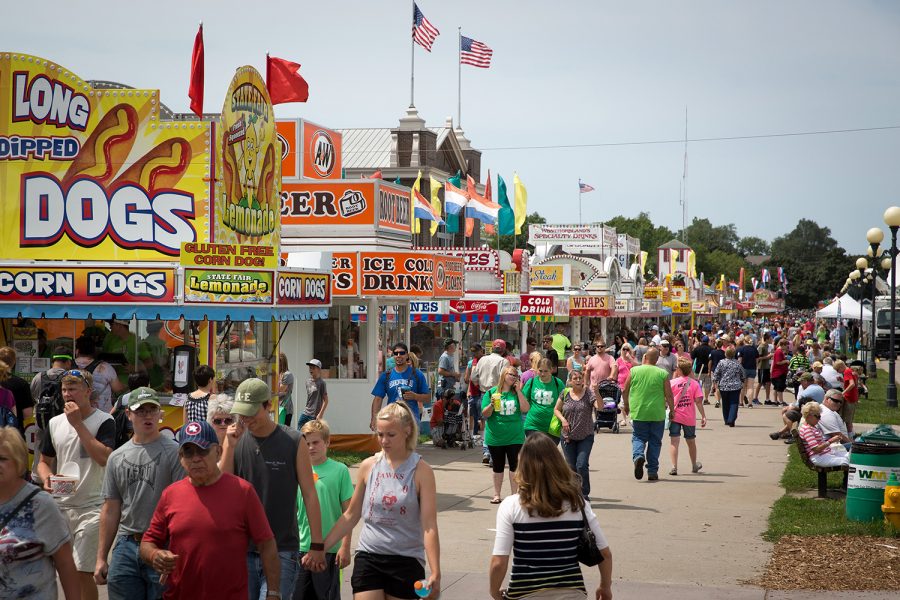A political guide to the Iowa State Fair
Ahead of Iowa’s first-in-the-nation caucuses, presidential candidates will have a platform at the Iowa State Fair.
Visitors walk past food vendors Aug. 13, 2015, at the Iowa State Fair in Des Moines, Iowa. (Scott Morgan/McClatchy DC/TNS)
July 30, 2019
The annual Iowa State Fair is set to take place this year on Aug. 8-18 in Des Moines, where more than 20 presidential-nomination candidates will make appearances and give 20-minute speeches.
The Des Moines Register Political Soapbox, a long-standing Iowa tradition, will give candidates a chance to speak on a raised platform on the fairground’s Grand Concourse ahead of Iowa’s first-in-the-nation caucuses.
Gary Slater, fair manager and CEO, said that while visiting candidates draw large crowds, the fair doesn’t necessarily see a surge in attendees during election years. In 2018, the fair drew a crowd of around 1.1 million people, a record, Slater said.
“I would say, by and large, people in Iowa attend the fair to get away from the daily grind of work or other things,” Slater said. “Maybe to get away from the television, to get away from the news.”
However, Slater said, three years ago, Sen. Bernie Sanders, former Sen. Hillary Clinton, and President Trump made campaign stops at the fair on the same day, which turned out to be a record Saturday in terms of attendance. Slater noted that the weather was also particularly nice that day.
“I definitely think it shows the relevance of the Iowa State Fair,” Slater said. “I think it shows the fact that the Iowa State Fair is something that matters to Iowans … because of that, those politicians want to be a part of that, and they want to get to know these people.”
The first Iowa State Fair was held in Fairfield in 1854 and moved to its present location at East 30th and East University in 1856, making the fairgrounds more than 165 years old. The 445-acre site was added to the National Register of Historic Places in 1987.
The fair has a long history of sitting presidents and hopefuls visiting the grounds. Calvin Coolidge spoke at the State Fair in 1925, and in 1936, Franklin Delano Roosevelt and a handful of other politicians met at the fair for a conference on the Midwestern drought. Dwight D. Eisenhower gave a speech in 1954 that was considered overtly political, and Jimmy Carter visited the fair in 1976 after winning the Democratic nomination.
RELATED: As surely as the seasons, State Fair approaches
Now, political campaigns — from statewide campaigns to presidential — use the fair as a way to lobby Iowans to knock on doors for their candidates and get people signed up on an email list for campaign updates and information.
In between the bustle of politicians and die-hard activists, the fair features its well-known fried foods and 69 entrees on a stick. A long list of foods and beverages $4 and under can be found on its website, as well as a Food Finder to locate fair favorites on the fairgrounds.
Another main feature of the fair is the Agriculture Expo, with statewide farmers showing off cattle and other livestock. In 2017, 5 lambs, 13 calves, 33 goats, 101 piglets, and 172 chicks were born at the Animal Learning Center, according to the State Fair website. The Avenue of Breeds, a location on the fairgrounds, represents 100 species, featuring approximately 100 to 120 animals.
Butter sculptures became a part of the fair in 1911, and the well-known Butter Cow consists of approximately 600 pounds of butter and takes nearly 16 hours to create. Once it is sculpted, the butter cows can be stored and reused for up to 10 years.
In addition to the Butter Cow, an additional sculpture or sculptures of butter stand in the Agriculture Building. This year, the companion sculpture will celebrate the 50th anniversary of “Sesame Street.” In 2018, a replica of the Waterloo Boy Tractor was created to celebrate the 100th anniversary of John Deere entering the tractor business.
Attendees can buy advanced-admission tickets — $8 for adults and $4 for children — online or at a participating Hy-Vee, Price Chopper, or Cash Saver store. Other ticket packages that include games and rides are available online.



